Statistics
2017 Health Manpower Survey
Summary of the Characteristics of Chinese Medicine Practitioners Enumerated
I. Chinese Medicine Practitioners Covered
1.1 The following three types of Chinese medicine practitioners were covered in the 2017 Health Manpower Survey on Chinese medicine practitioners (HMS - CMP), with exclusion of those subsequently found to have passed away on or before the survey reference date of 31 August 2017.
| (i) | Registered Chinese Medicine Practitioners |
| Refer to registered Chinese medicine practitioners who were registered with the Chinese Medicine Council of Hong Kong under section 69 of the Chinese Medicine Ordinance (Chapter 549) as at the survey reference date. | |
| (ii) | Chinese Medicine Practitioners with Limited Registration |
| Refer to Chinese medicine practitioners with limited registration who were registered with the Chinese Medicine Council of Hong Kong under section 85 of the Chinese Medicine Ordinance (Chapter 549) as at the survey reference date. | |
| (iii) | Listed Chinese Medicine Practitioners |
| Refer to listed Chinese medicine practitioners whose names had been entered on the list of listed Chinese medicine practitioners maintained by the Chinese Medicine Council of Hong Kong under section 90 of the Chinese Medicine Ordinance (Chapter 549) as at the survey reference date. |
1.2 Of the 9 612 Chinese medicine practitioners covered, 6 951 (72.3%) were registered Chinese medicine practitioners, 40 (0.4%) were Chinese medicine practitioners with limited registration and 2 621 (27.3%) were listed Chinese medicine practitioners.
II. Response Rate
2.1 Of the 9 612 Chinese medicine practitioners covered, 2 380 responded to the survey, giving an overall response rate of 24.8%. Analysed by type of Chinese medicine practitioners, the response rate of registered Chinese medicine practitioners was 28.3%, while that of Chinese medicine practitioners with limited registration and listed Chinese medicine practitioners were 47.5% and 15.0% respectively.
III. Registered Chinese Medicine Practitioners
3.1 Of the 6 951 registered Chinese medicine practitioners covered, 1 969 responded to the survey. Among the respondents, 1 768 (89.8%) were economically active (active)*† and 201 (10.2%) were economically inactive (inactive)*‡ in the local Chinese medicine profession (Chart A).
| * | In the survey, the criteria used in defining economically active / inactive followed those recommended by the International Labour Organization, which are also being used by the Census and Statistics Department in Hong Kong. |
| † | "Economically active" registered Chinese medicine practitioners comprised all "employed" and "unemployed" registered Chinese medicine practitioners. "Employed" registered Chinese medicine practitioners referred to those registered Chinese medicine practitioners practising in the Chinese medicine profession in Hong Kong during the survey period, while "unemployed" registered Chinese medicine practitioners referred to those registered Chinese medicine practitioners who (a) were not practising in the local Chinese medicine profession during the survey period; (b) had been available for work during the seven days before the survey; AND (c) had sought work in the local Chinese medicine profession during the 30 days before the survey. |
| ‡ | "Economically inactive" registered Chinese medicine practitioners comprised registered Chinese medicine practitioners who were not practising in the Chinese medicine profession in Hong Kong during the survey period, excluding those who had been on leave during the survey period and who were "economically active" but "unemployed". |
3.2 Of the 1 768 active registered Chinese medicine practitioners enumerated, 1 728 (97.7%) were practising in the local Chinese medicine profession, 15 (0.8%) were seeking jobs, 11 (0.6%) were having temporary sickness, and 14 (0.8%) were starting business at subsequent date, waiting to take up a new job, expecting to return to their original jobs or believed that work was not available in the local Chinese medicine profession during the 30 days before the survey. The survey results presented in paragraph 3.4 below were based on the 1 728 responding registered Chinese medicine practitioners who were practising in the local Chinese medicine profession as at 31 August 2017. The percentages presented below may not add up to 100% due to missing responses or rounding (Chart A).
Chart A : Activity Status of Registered Chinese Medicine Practitioners Covered
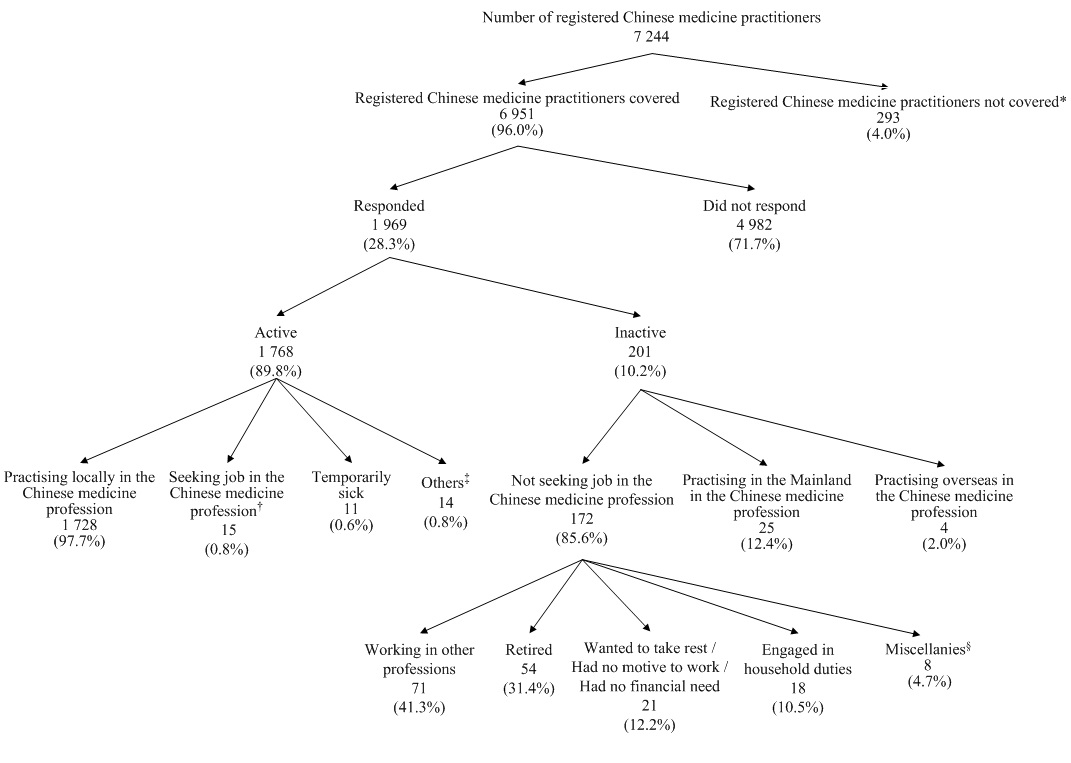
| Note: | * | Figure refers to the number of registered Chinese medicine practitioners subsequently found to have passed away on or before 31.8.2017. |
| † | Figure refers to the number of responding registered Chinese medicine practitioners who (a) were not practising in the Chinese medicine profession in Hong Kong during the survey period; (b) had been available for work during the seven days before the survey; AND (c) had sought work in the Chinese medicine profession during the 30 days before the survey. | |
| ‡ | Figure refers to the number of responding registered Chinese medicine practitioners who (a) were not practising in the Chinese medicine profession in Hong Kong during the survey period; (b) had been available for work during the seven days before the survey; AND (c) were starting business at subsequent date, waiting to take up a new job, expecting to return to their original jobs in the local Chinese medicine profession or believed that work was not available during the 30 days before the survey. | |
| § | Figure refers to the number of responding registered Chinese medicine practitioners who reported undertaking study, emigrated, etc. | |
| Percentages may not add up to 100% due to rounding. |
3.3 Of the 201 inactive registered Chinese medicine practitioners enumerated, 25 (12.4%) reported practising in the Mainland, four (2.0%) reported practising overseas and 172 (85.6%) reported not seeking jobs in the local Chinese medicine profession during the 30 days before the survey. Among the 172 inactive registered Chinese medicine practitioners who reported not seeking jobs in the local Chinese medicine profession, the main reasons included: 71 (41.3%) were working in other professions, 54 (31.4%) were retired, 21 (12.2%) wanted to take a rest / had no motive to work / had no financial need and 18 (10.5%) were engaged in household duties (Chart A).
3.4 Two active registered Chinese medicine practitioners did not indicate the gender. Of the remaining 1 726 active registered Chinese medicine practitioners enumerated, 1 059 (61.4%) were male and 667 (38.6%) were female, giving an overall sex ratio (males per 100 females) of 159. Apart from 12 registered Chinese medicine practitioners who did not indicate their age, the median age of the remaining 1 716 active registered Chinese medicine practitioners enumerated was 58.0 years. The median age of the active female Chinese medicine practitioners enumerated was 50.0 years and that of their male counterparts was 61.0 years.
3.5 The responding active registered Chinese medicine practitioners were requested to indicate the characteristics of their main jobs*. Distribution by sector for the main job showed that the largest proportion 1 469 (85.0%) were working in the private sector, followed by 97 (5.6%) in the subvented sector, 80 (4.6%) in the Hospital Authority, 64 (3.7%) in the academic sector and 13 (0.8%) in the Government.
3.6 The median age of the active registered Chinese medicine practitioners enumerated was highest (59.0 years) for those working in the private sector, followed by the academic sector (39.0 years), the Government (37.0 years), the subvented sector (33.0 years) and the Hospital Authority (31.0 years).
3.7 Of the 1 728 active registered Chinese medicine practitioners enumerated, 81.6% spent most of their working time on clinical general practice, whilst 9.5% and 5.6% on clinical bone-setting and clinical acupuncture respectively.
3.8 The median number of hours of work (excluding meal breaks) per week of the 1 728 active registered Chinese medicine practitioners enumerated was 42.0 hours. Among them, 237 (13.7%) registered Chinese medicine practitioners were required to undertake on-call duty (excluding normal duty), with a median of 10.0 hours of on-call duty (excluding normal duty) per week.
3.9 Of the 1 728 active registered Chinese medicine practitioners enumerated, 59.0% had passed the Licensing Examination (Section 61(1)(a) of the Chinese Medicine Ordinance) as their earliest basic qualifications. Listed Chinese medicine practitioners who had been exempted from the Licensing Examination (Section 93 of the Chinese Medicine Ordinance), who had passed the Registration Assessment (Section 94 of the Chinese Medicine Ordinance) and who had passed the Licensing Examination (Section 95 of the Chinese Medicine Ordinance) accounted for 17.8%, 10.7% and 11.8% respectively.
3.10 Of the 1 728 active registered Chinese medicine practitioners enumerated, 1 062 (61.5%) had received / were receiving additional training after they became Chinese medicine practitioners. Of the 1 062 active registered Chinese medicine practitioners with additional training, 43 (4.0%) had not yet completed the additional training, 397 (37.4%) held Master’s Degree, 268 (25.2%) held Certificate, 137 (12.9%) held Doctoral Degree, 127 (12.0%) held Bachelor’s Degree and 75 (7.1%) held Diploma as the highest qualification.
3.11 Of the 1 062 active registered Chinese medicine practitioners enumerated who had received / were receiving additional training, 635 (59.8%) had received / were receiving training in one field only. Among them, 27.7% had received / were receiving additional training in acupuncture and moxibustion of Chinese Medicine, 15.3% in Chinese medicine (general practice), 14.0% in internal medicine of Chinese medicine, 10.7% in orthopaedics and traumatology of Chinese medicine and 5.2% in integration of Chinese-Western medicine (Chart B).
| * | Main jobs referred to the jobs in which the registered Chinese medicine practitioners had spent most of their working time. |
Chart B : Number of Field(s) of Additional Training Received / Being Received by Active Registered Chinese Medicine Practitioners Enumerated
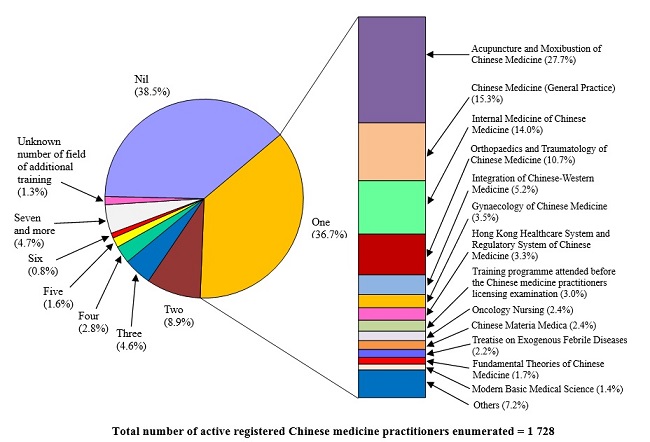
3.12 For the active registered Chinese medicine practitioners who had indicated more than one field of additional training, the total number of counts of active registered Chinese medicine practitioners enumerated for additional training was 2 490, in which 17.1% had received / were receiving additional training in acupuncture and moxibustion of Chinese medicine, 12.5% in internal medicine of Chinese medicine, 10.6% in orthopaedics and traumatology of Chinese medicine, 7.0% in gynaecology of Chinese medicine, 6.0% in treatise on exogenous febrile diseases and 5.3% in integration of Chinese-western medicine.
3.13 Regarding Continuing Education in Chinese Medicine (CME) activities, 1 673 (96.8%) of the active registered Chinese medicine practitioners reported that they had participated in CME activities in 2017, 44 (2.5%) reported no participation in any CME activities, whilst 11 (0.6%) did not report whether they had participated in CME activities or not. Among the 1 673 active registered Chinese medicine practitioners enumerated who had participated in CME activities, the distribution of CME points attained in the past 12 months was: 1 to 10 points (7.7%), 11 to 20 points (22.7%), 21 to 30 points (19.1%), 31 to 40 points (10.3%) and more than 40 points (40.2%)
IV. Chinese Medicine Practitioners with Limited Registration
4.1 Under section 83 of the Chinese Medicine Ordinance, where an educational or scientific research institution intends to engage a limited registered Chinese medicine practitioner, to perform predominantly clinical teaching or research in Chinese medicine for the institution, the institution may apply to the Chinese Medicine Practitioners Board on behalf of the person for limited registration of that person. Thus, all the 19 responding Chinese medicine practitioners with limited registration were economically active (active) in the local Chinese medicine profession*† (Chart C).
Chart C : Activity Status of Chinese Medicine Practitioners with Limited Registration Covered
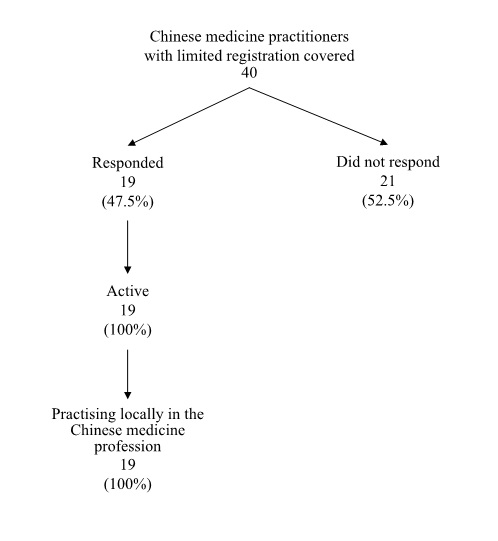
| * | In the survey, the criteria used in defining economically active/inactive followed those recommended by the International Labour Organization, which are also being used by the Census and Statistics Department in Hong Kong. |
| † | "Economically active" Chinese medicine practitioners with limited registration comprised all "employed" and "unemployed" Chinese medicine practitioners with limited registration. "Employed" Chinese medicine practitioners with limited registration referred to those Chinese medicine practitioners with limited registration practising in the Chinese medicine profession in Hong Kong during the survey period, while "unemployed" Chinese medicine practitioners with limited registration referred to Chinese medicine practitioners with limited registration who (a) were not practising in the local Chinese medicine profession during the survey period; (b) had been available for work during the seven days before the survey; AND (c) had sought work in the local Chinese medicine profession during the 30 days before the survey. |
4.2 Of the 19 active Chinese medicine practitioners with limited registration enumerated, 16 (84.2%) were male and three (15.8%) were female, giving an overall sex ratio (males per 100 females) of 533. The median age of the 19 active Chinese medicine practitioners with limited registration enumerated was 63.0 years. The median age of the active female Chinese medicine practitioners with limited registration enumerated was 71.0 years and that of their male counterparts was 62.0 years.
4.3 The responding active Chinese medicine practitioners with limited registration were requested to indicate the characteristics of their main jobs*. Distribution by the sector for the main job showed that all Chinese medicine practitioners with limited registration were working in the academic sector.
4.4 Of the 19 active Chinese medicine practitioners with limited registration enumerated, 63.2% spent most of their working time on teaching, followed by 26.3% on general practice, research and bone-setting were both 5.3%.
4.5 The median number of hours of work (excluding meal breaks) per week of the 19 active Chinese medicine practitioners with limited registration enumerated was 39.0 hours. Among them, three (15.8%) were required to undertake on-call duty (excluding normal duty).
4.6 Of the 19 active Chinese medicine practitioners with limited registration enumerated, five (26.3%) had received / were receiving additional training after they became Chinese medicine practitioners. Of the five active Chinese medicine practitioners with limited registration with additional training, two (40.0%) held Certificate as the highest qualification.
4.7 Of the five Chinese medicine practitioners with limited registration with additional training, two (40.0%) had received / were receiving training in one field only. Among them, all had received / were receiving additional training in integration of Chinese-Western medicine.
| * | Main jobs referred to the jobs in which the Chinese medicine practitioners with limited registration had spent most of their working time. |
V. Listed Chinese Medicine Practitioners
5.1 Among the 392 responding listed Chinese medicine practitioners, 309 (78.8%) were economically active*† (active) and 83 (21.2%) were economically inactive*‡ (inactive) in the local Chinese medicine profession (Chart D).
5.2 Of the 309 active listed Chinese medicine practitioners enumerated, 293 (94.8%) were practising in the local Chinese medicine profession, four (1.3%) were having temporary sickness, two (0.6%) were seeking jobs and ten (3.2%) were waiting to take up a new job, expecting to return to their original jobs, starting business at subsequent date or believed that work was not available in the local Chinese medicine profession during the 30 days before the survey. The survey results presented in paragraph 5.4 below were based on the 293 responding listed Chinese medicine practitioners practising in the local Chinese medicine profession as at 31 August 2017. The percentages presented below may not add up to 100% due to missing responses or rounding (Chart D).
5.3 Of the 83 inactive listed Chinese medicine practitioners enumerated, nine (10.8%) reported practising in the Mainland, two (2.4%) reported practising overseas and 72 (86.7%) reported not practising in the Chinese medicine profession in Hong Kong and not seeking job in the local Chinese medicine profession during the 30 days before the survey. The main reasons included: 37 (51.4%) were retired and 21 (29.2%) were working in other professions (Chart D).
| * | In the survey, the criteria used in defining economically active / inactive followed those recommended by the International Labour Organization, which are also being used by the Census and Statistics Department in Hong Kong. |
| † | "Economically active" listed Chinese medicine practitioners comprised all "employed" and "unemployed" listed Chinese medicine practitioners. "Employed" listed Chinese medicine practitioners referred to those listed Chinese medicine practitioners practising in the Chinese medicine profession in Hong Kong during the survey period, while "unemployed" listed Chinese medicine practitioners referred to those listed Chinese medicine practitioners who (a) were not practising in the Chinese medicine profession during the survey period; (b) had been available for work during the seven days before the survey; AND (c) had sought work in the Chinese medicine profession during the 30 days before the survey. |
| ‡ | "Economically inactive" listed Chinese medicine practitioners comprised the listed Chinese medicine practitioners who were not practising in the Chinese medicine profession in Hong Kong during the survey period, but excluding those who had been on leave during the survey period and who were "economically active" but "unemployed". |
Chart D : Activity Status of Listed Chinese Medicine Practitioners Covered
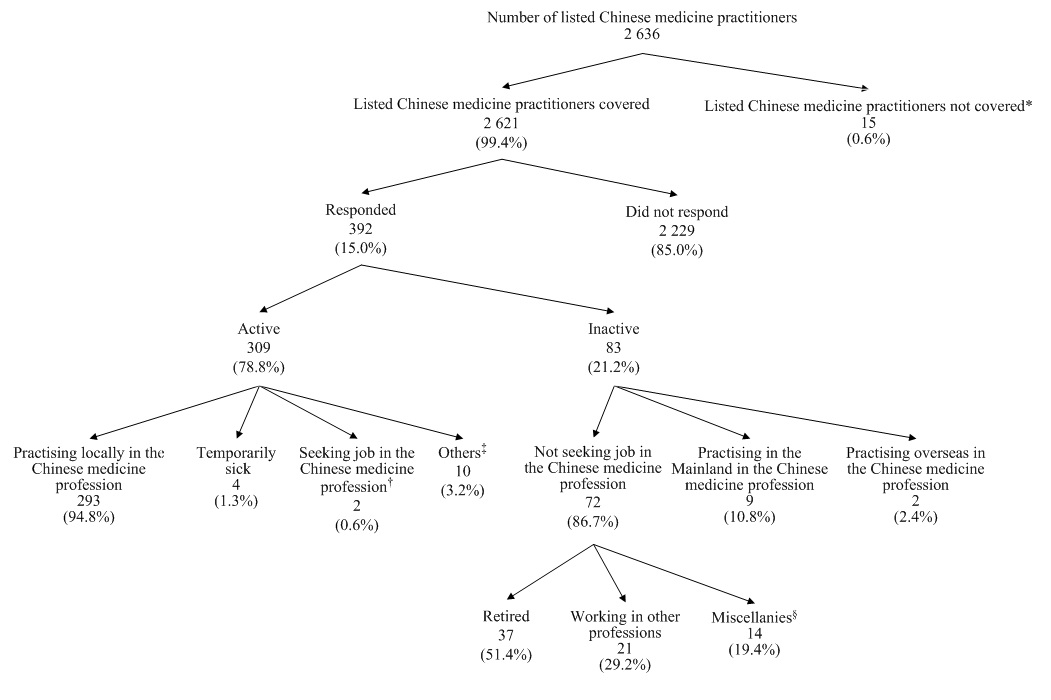
| Note: | * | Figure refers to the number of listed Chinese medicine practitioners subsequently found to have passed away on or before 31.8.2017. |
| † | Figure refers to the number of responding listed Chinese medicine practitioners who (a) were not practising in the Chinese medicine profession in Hong Kong during the survey period; (b) had been available for work during the seven days before the survey; AND (c) had sought work in the Chinese medicine profession during the 30 days before the survey. | |
| ‡ | Figure refers to the number of responding listed Chinese medicine practitioner who (a) was not practising in the Chinese medicine profession in Hong Kong during the survey period; (b) had been available for work during the seven days before the survey; AND (c) were waiting to take up a new job, expecting to return to their original jobs, starting business at subsequent date or believed that work was not available in the local Chinese medicine profession during the 30 days before the survey. | |
| § | Figure refers to the number of responding listed Chinese medicine practitioners who wanted to take rest / had no motive to work / had no financial need, were engaged in household duties, etc. | |
| Percentages may not add up to 100% due to rounding. |
5.4 Of the 293 active listed Chinese medicine practitioners enumerated, 223 (76.1%) were male and 70 (23.9%) were female, giving an overall sex ratio (males per 100 females) of 319. Apart from five listed Chinese medicine practitioners who did not indicate their age, the median age of the remaining 288 active listed Chinese medicine practitioners enumerated was 65.0 years. The median age of the active female listed Chinese medicine practitioners enumerated was 64.0 years and that of their male counterparts was 65.0 years.
5.5 The responding active listed Chinese medicine practitioners were requested to indicate the characteristics of their main jobs*. Distributed by sector for the main job showed that 97.3% of the active listed Chinese medicine practitioners enumerated were working in the private sector.
| * | Main jobs referred to the job in which the listed Chinese medicine practitioners had spent most of their working time. |
5.6 Of the 293 active listed Chinese medicine practitioners enumerated, 53.2% spent most of their working time on clinical general practice, whilst 29.4% and 9.2% on clinical bone-setting and clinical acupuncture respectively.
5.7 The median number of hours of work (excluding meal breaks) per week of the 293 active listed Chinese medicine practitioners enumerated was 40.0 hours. Among them, 42 (14.3%) were required to undertake on-call duty (excluding normal duty), with a median of 12.0 hours of on-call duty (excluding normal duty) per week.
5.8 Of the 293 active listed Chinese medicine practitioners enumerated, 162 (55.3%) had received / were receiving additional training after they became Chinese medicine practitioners. Of the 162 active listed Chinese medicine practitioners with additional training, 11 (6.8%) had not yet completed the additional training, 87 (53.7%) held Certificate, 35 (21.6%) held Diploma and 18 (11.1%) held Bachelor’s Degree as the highest qualification.
5.9 Of the 162 active listed Chinese medicine practitioners who had received / were receiving additional training, 85 (52.5%) had received / were receiving training in one field only. Among them, 31.8% had received / were receiving additional training in Chinese medicine (general practice), 23.5% in orthopaedics and traumatology of Chinese medicine, 14.1% in acupuncture and moxibustion of Chinese medicine, 11.8% in training programme attended before the Chinese medicine practitioners licensing examination and 9.4% in internal medicine of Chinese medicine (Chart E).
5.10 For the active listed Chinese medicine practitioners who had indicated more than one field of additional training, the total number of count of active listed Chinese medicine practitioners enumerated for additional training was 591, in which 11.7% received additional training in orthopaedics and traumatology of Chinese medicine. Acupuncture and moxibustion of Chinese medicine and internal medicine of Chinese medicine were both 9.6%; 7.4% in medical prescriptions in Chinese medicine, fundamental theories of Chinese medicine and Chinese materia medica were both 6.9%; and 6.8% in diagnostics of Chinese medicine.
Chart E : Number of Field(s) of Additional Training Received / Being Received by Active Listed Chinese Medicine Practitioners Enumerated
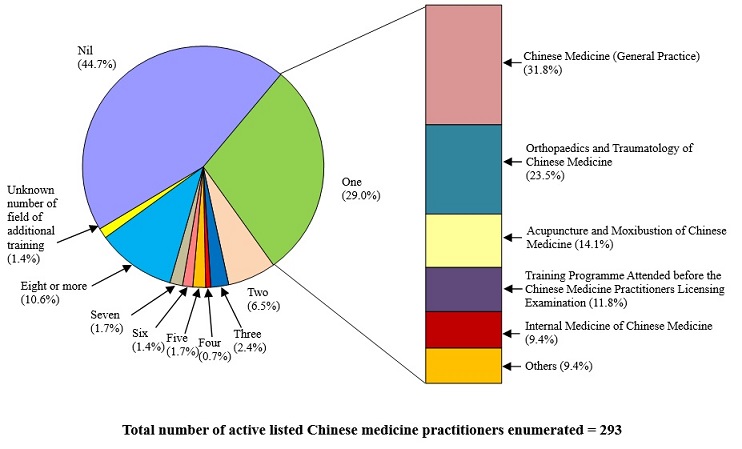
VI. Trend Analysis
6.1 The number of registered Chinese medicine practitioners covered increased from 6 243 in 2011 to 6 951 in 2017. The number of Chinese medicine practitioners with limited registration covered decreased from 71 in 2011 to 40 in 2017, while the number of listed Chinese medicine practitioners covered decreased from 2 763 in 2011 to 2 621 in 2017 (Chart F).
Chart F : Number of Chinese Medicine Practitioners Enumerated by Year (2011, 2014 and 2017)
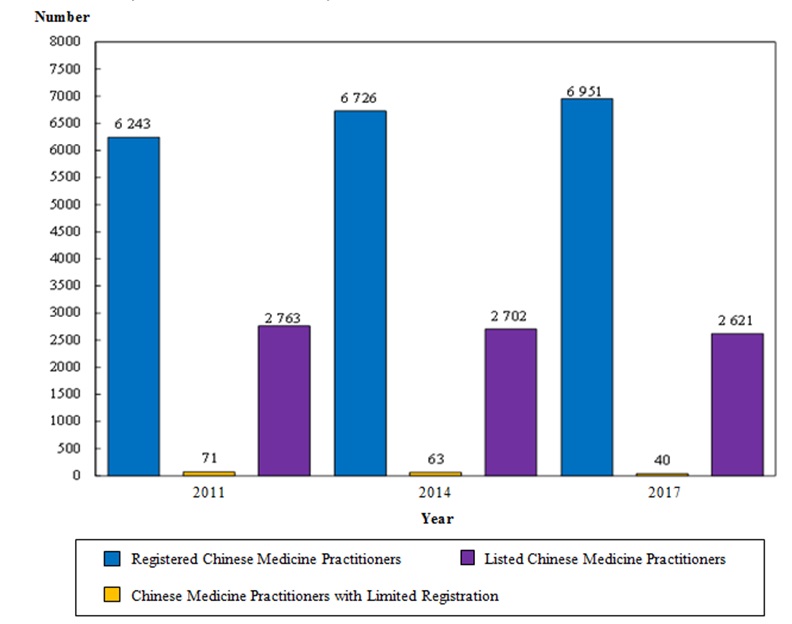
| Note: | Figures refer to Chinese medicine practitioners registered with the Chinese Medicine Council of Hong Kong or entered on the list of listed Chinese medicine practitioners maintained by the Chinese Medicine Council of Hong Kong under the Chinese Medicine Ordinance (Chapter 549) as at 31st August of the respective years. Figure of 2017 excluded those who were subsequently found to have passed away on or before the survey reference date of 31 August 2017. |
6.2 The median age of the active registered Chinese medicine practitioners enumerated remained largely stable (58.0 years in 2011, 2014 and 2017). From 2011 to 2017, the median age of the active Chinese medicine practitioners with limited registration enumerated increase from 53.0 years to 63.0 years, while the median age of the active listed Chinese medicine practitioners enumerated increased from 60.0 years to 65.0 years (Table A).
6.3 The sex ratio (males per 100 females) of active registered Chinese medicine practitioners enumerated decreased from 209 in 2011 to 159 in 2017. From 2011 to 2017, the sex ratio (males per 100 females) of active Chinese medicine practitioners with limited registration enumerated increased from 117 to 533, while the sex ratio (males per 100 females) of active listed Chinese medicine practitioners enumerated varied between 268 to 421 (Table A).
6.4 From 2011 to 2017, the largest proportion of active registered Chinese medicine practitioners enumerated were working in the private sector, accounting for more than 85% of the registered Chinese medicine practitioners. A similar distribution was observed in listed Chinese medicine practitioners with more than 95% of the listed Chinese medicine practitioners working in the private sector during the same period. The proportion of active Chinese medicine practitioners with limited registration enumerated working in the academic sector increased from 61.5% to 100.0% from 2011 to 2017 (Table A).
Table A : Selected Characteristics of Active Chinese Medicine Practitioners Enumerated (2011, 2014 and 2017)
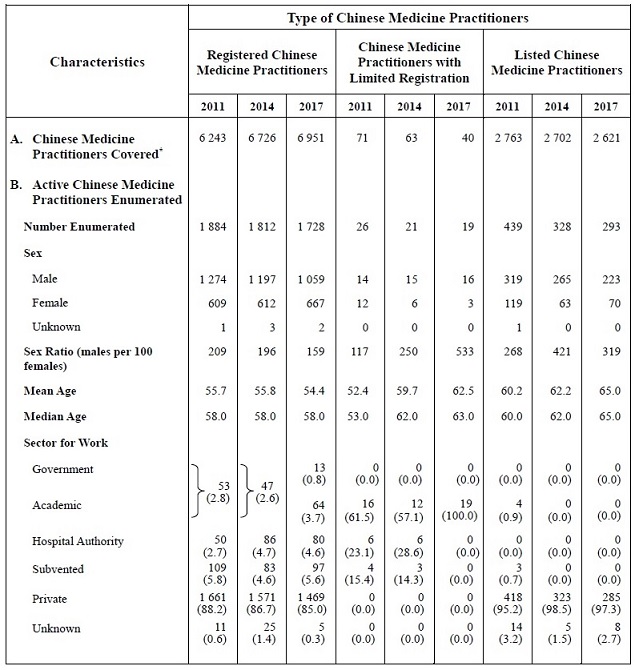
| Note: | * | Figures refer to Chinese medicine practitioners registered with the Chinese Medicine Council of Hong Kong or entered on the list of listed Chinese medicine practitioners maintained by the Chinese Medicine Council of Hong Kong under the Chinese Medicine Ordinance (Chapter 549) as at 31st August of the respective years. Figure of 2017 excluded those who were subsequently found to have passed away on or before the survey reference date of 31 August 2017. |
| There may be slight discrepancy between the sum of individual items and the total due to rounding. |
VII. Limitations of Findings
7.1 The survey findings only represented the situation as at the survey reference date of 31 August 2017. Analysis on the characteristics of Chinese medicine practitioners performed was based on the data collected on those enumerated Chinese medicine practitioners only. As the characteristics of the non-responding Chinese medicine practitioners may be different from those who responded, the findings may not fully reflect the characteristics of all Chinese medicine practitioners practising in Hong Kong.
7.2 Since the number of Chinese medicine practitioners involved in some of the results was small, readers should interpret the relevant statistics with caution.